Python进阶11---异常及模块化
异常处理
异常Exception




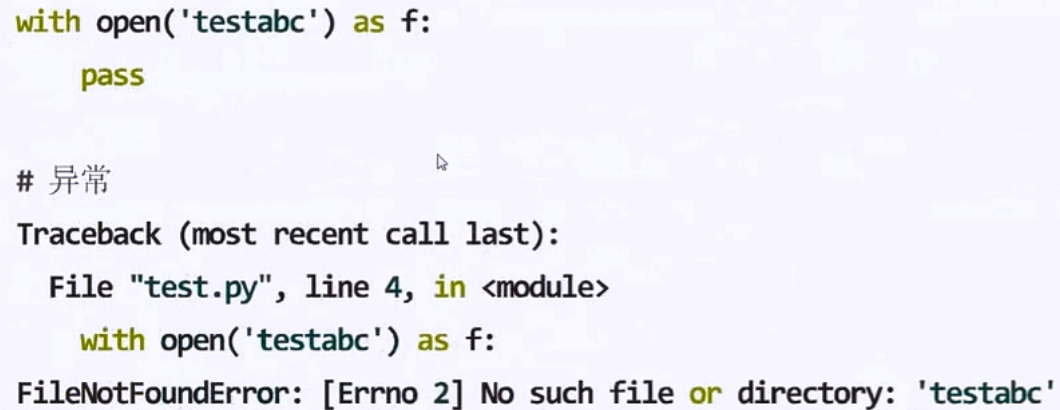
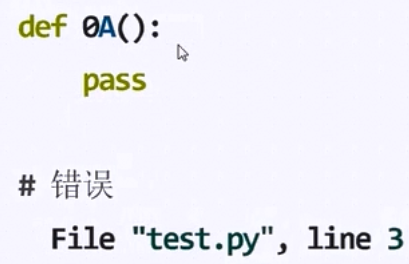


产生异常

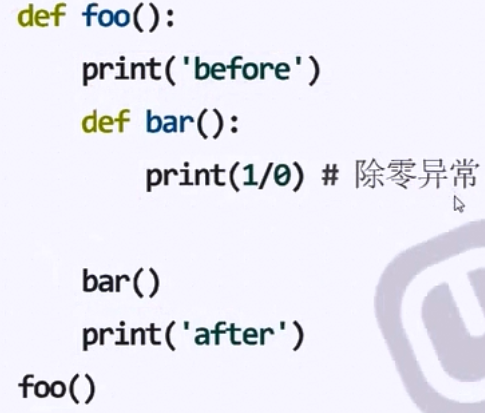
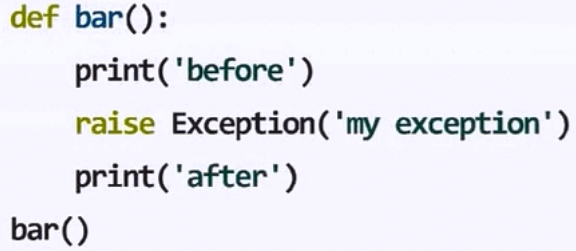

异常的捕获
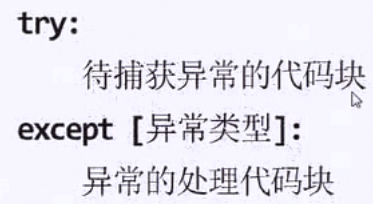


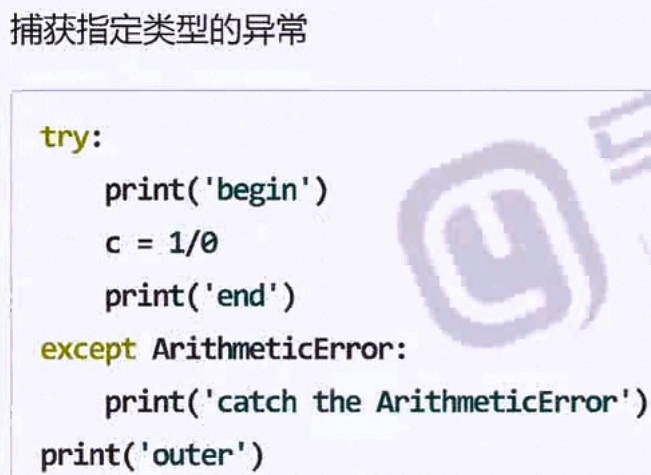
异常类及继承层次


BaseException及子类


执行!


Exception及子类

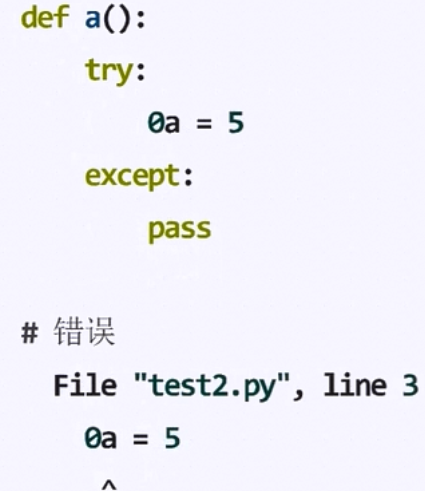 --
--
![]()

自定义异常
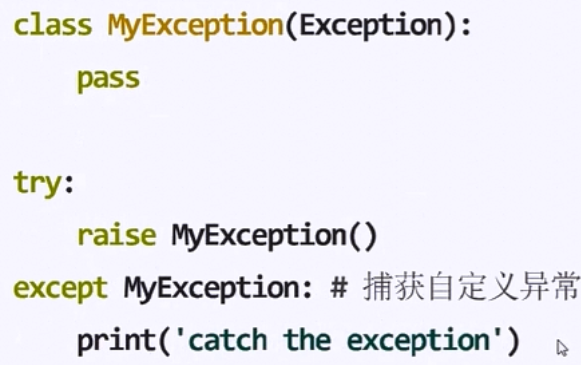
异常的捕获
![]()



as子句
![]()
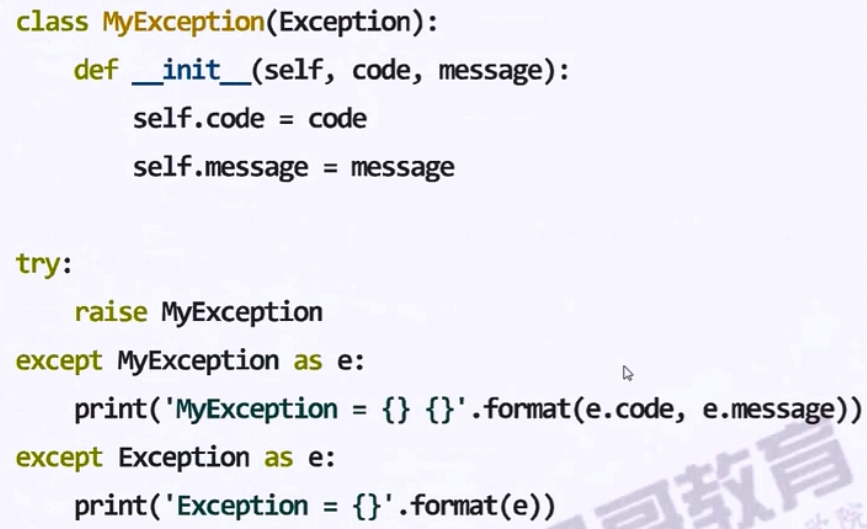

![]()
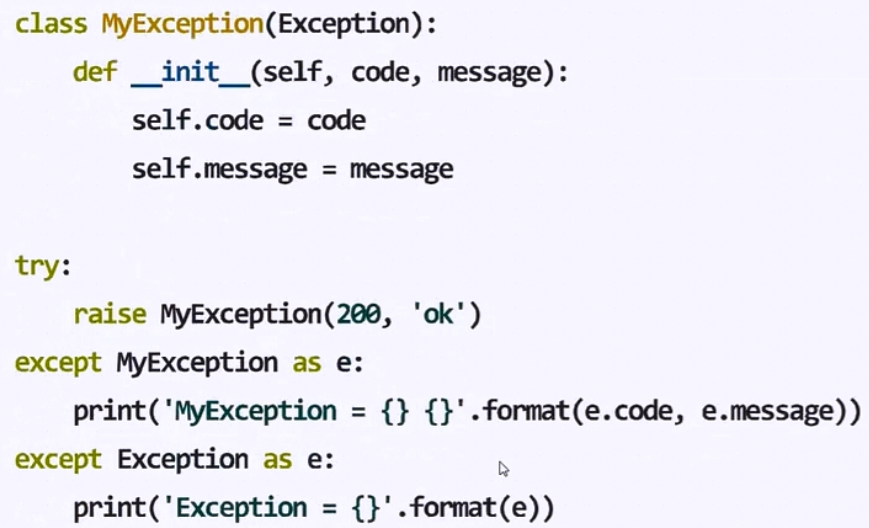
finally子句

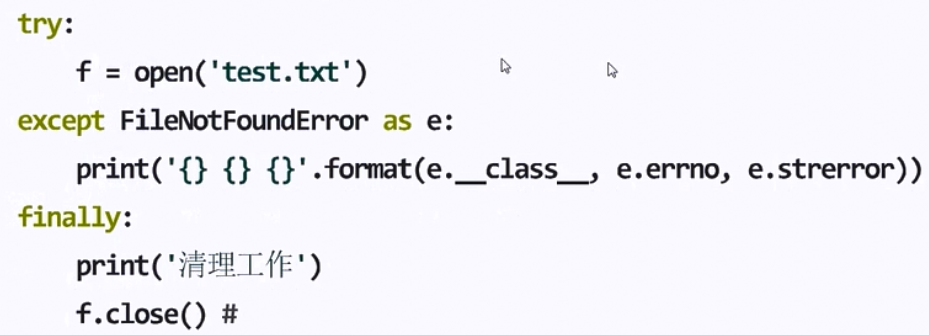

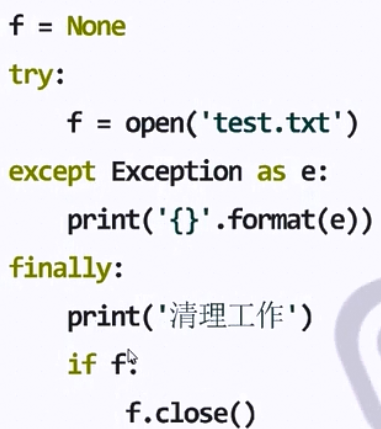
![]()
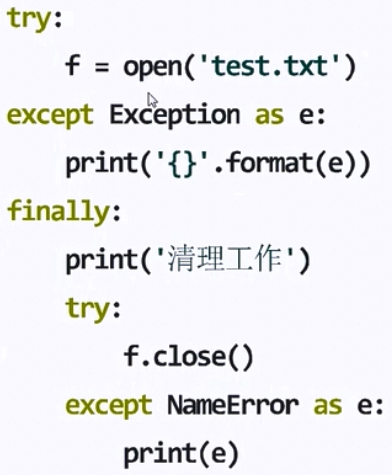
finally执行时机

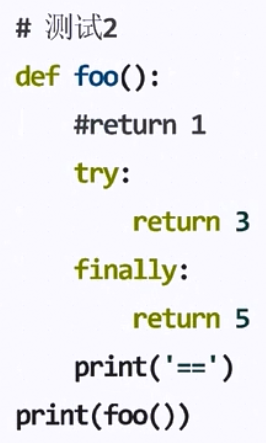

异常的传递
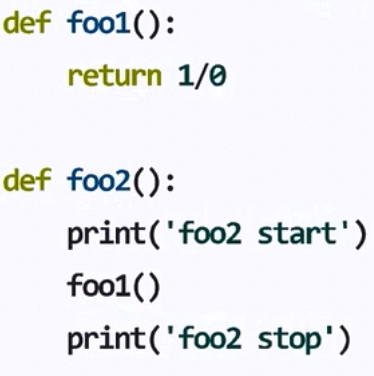
![]()

# Author: Baozi #-*- codeing:utf-8 -*- #线程中测试异常 import threading import time def foo1(): return 1/0 def foo2(): time.sleep(3)#3秒后抛出异常 print('foo2 start') foo1() print('foo2 stop') t = threading.Thread(target=foo2) t.start() print('t-->starting') while True: time.sleep(1) print('Everything OK') if t.is_alive(): print('alive') else: print('dead')
try嵌套
try: try: ret = 1/0 except KeyError as e: print(e) else: print('OK') finally: print('inner fin') except: print('outer catch') finally: print('outer fin') #输出如下: inner fin outer catch outer fin
内部捕获不到异常,会向外层传递异常
但是如果内层有finally且其中有return、break语句,则异常不会继续向外抛出!
def foo(): try: ret = 1/0 except KeyError as e: print(e) finally: print('inner fin') return # 异常被丢弃 try: foo() except: print('outer catch') finally: print('outer fin') #输出如下: inner fin outer fin
异常的捕获机制
1.立即捕获
![]()
def parse_int(s): try: return int(s) except: return 0 print(parse_int('sss'))
2边界捕获

else子句
try: ret = 1*0 except ArithmeticError as e: print(e) else: print('ok') finally: print('fin')

总结
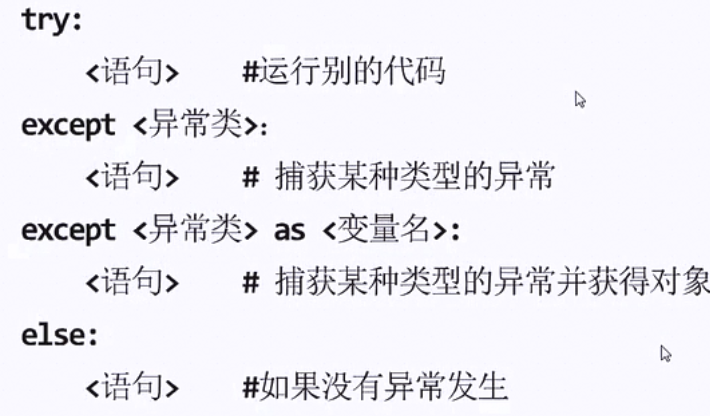

try的工作原理

模块化

导入语句

单独运行下面例子,体会区别




总结
![]()


from语句



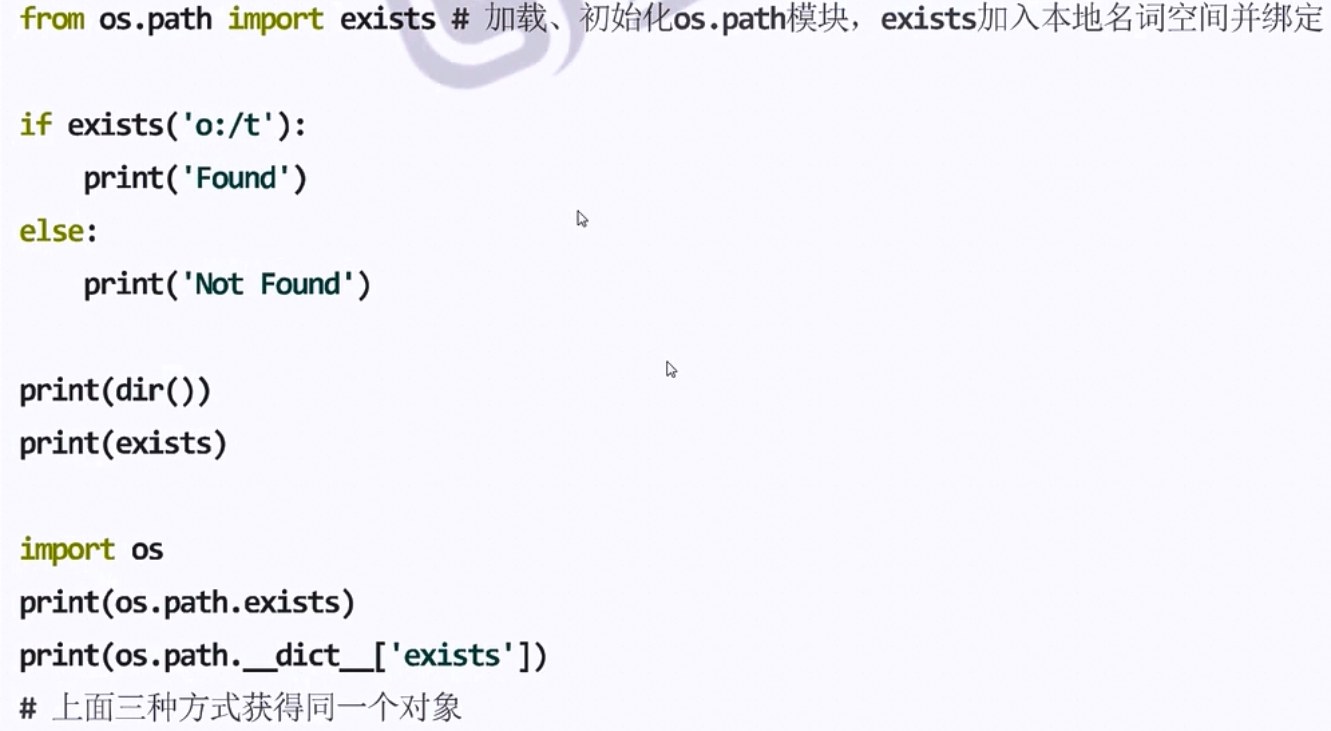
总结



自定义模块
![]()
#test1.py文件 print("This is test1 module") class A: def showmodule(self): print("{}.a = {}".format(self.__module__,self)) print(self.__class__.__name__) a = A() a.showmodule() #输出如下: This is test1 module __main__.a = <__main__.A object at 0x00000000028E5630> A #test2.py文件 import test1 a = test1.A() a.showmodule() #test3.py文件 from test1 import A as cls a = cls() a.showmodule() #test2.py和test3.py文件输出如下: This is test1 module test1.a = <test1.A object at 0x00000000029C2F98> A test1.a = <test1.A object at 0x0000000001DC5518> A
自定义模块命名规范

模块搜索顺序
![]()
import sys for i in sys.path: print(i) #输出如下: F:\code_python_urllib_demo\Python全栈开发--异常及模块 F:\code_python_urllib_demo D:\Anaconda3\python36.zip D:\Anaconda3\DLLs D:\Anaconda3\lib D:\Anaconda3 D:\Anaconda3\lib\site-packages D:\Anaconda3\lib\site-packages\Sphinx-1.5.6-py3.6.egg D:\Anaconda3\lib\site-packages\pip-9.0.1-py3.6.egg D:\Anaconda3\lib\site-packages\win32 D:\Anaconda3\lib\site-packages\win32\lib D:\Anaconda3\lib\site-packages\Pythonwin D:\Anaconda3\lib\site-packages\setuptools-27.2.0-py3.6.egg D:\pycharm\PyCharm 2017.3.4\helpers\pycharm_matplotlib_backend


模块的重复导入
#test1.py文件 print("This is test1 module") class A: def showmodule(self): print("{}.a = {}".format(self.__module__,self)) print(self.__class__.__name__) a = A() a.showmodule() #test2.py文件 import test1 print('local module') import test1

模块的运行


#test1.py文件 import test2 #test2.py文件 #判断模块是否以程序的方式运行 if __name__ == '__main__': print('in __main__')#程序的方式运行 else: print('in import module')#模块导入的方式运行
if __name__ == '__main__':用途

模块的属性
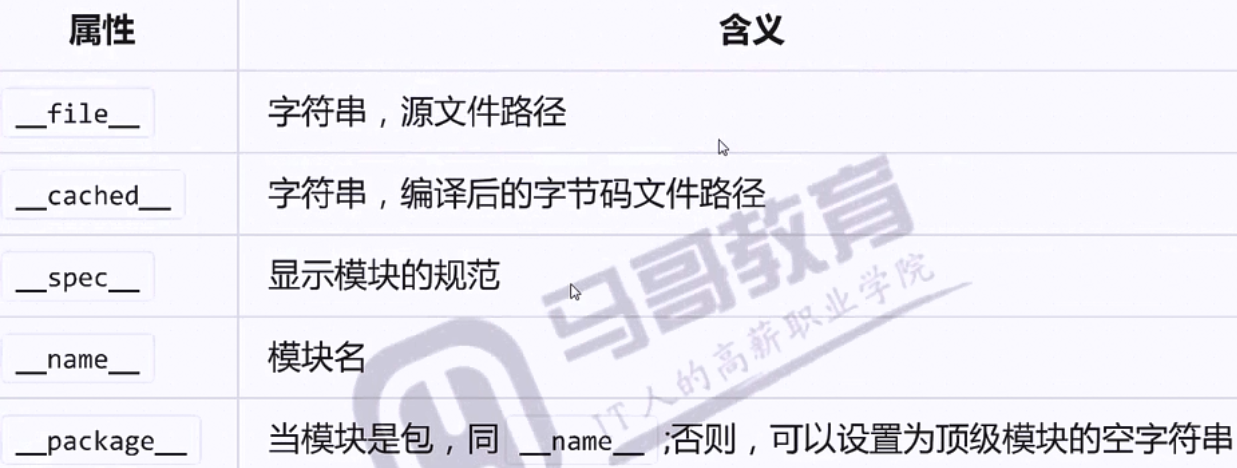
包
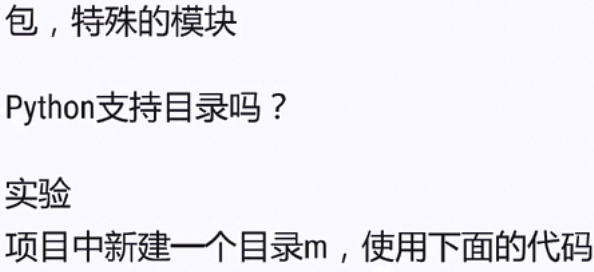
import m print(m) print(type(m)) print(dir(m))#没有__file__ #输出如下: <module 'm' (namespace)> <class 'module'> ['__doc__', '__loader__', '__name__', '__package__', '__path__', '__spec__']
![]()
![]()


子模块
![]()
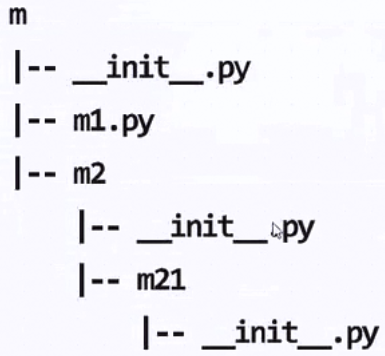
![]()
#注意查看模块的加载,当前名词空间 import m # import m.m1 # from m import m1 # from m.m2 import m21 # import m.m2.m21 print(dir()) import sys print(sorted(sys.modules.keys()))

模块和包的总结



绝对导入、相对导入
绝对导入

相对导入

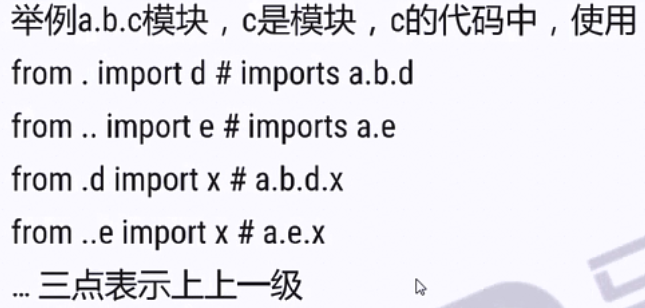
![]()
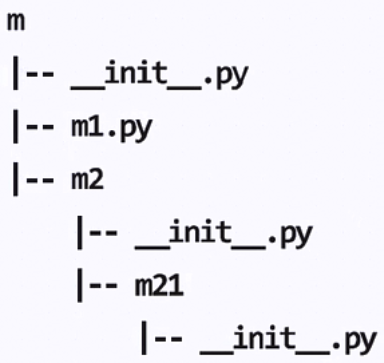

访问控制
下划线开头的模块名

模块内的标识符
#xyz.py文件 print(__name__) A = 5 _B = 6 __C = 7 __my__ = 8 #test.py文件 import xyz import sys print(dir())#['__annotations__',..., 'sys', 'xyz'] print(xyz.A,xyz._B,xyz.__C,xyz.__my__)#5 6 7 8

from语句
#修改test.py文件 from xyz import A,_B as B,__my__,__C as C import sys#xyz print(dir())#['A', 'B', 'C', '__annotations__', ...,'__my__',..., '__spec__', 'sys'] print(A,B,__my__,C)#5 6 8 7
![]()
from ... import * 和 __all__
使用from ... import * 导入
#修改test.py文件 from xyz import * import sys print(dir())#['A', ... , 'sys'] print(locals()['A']) print(sorted(locals().keys()))#['A', ... , 'sys'] A = 55 print(locals()['A'])
![]()
使用 __all__
![]()
#修改xyz.py文件 __all__ = ["X","Y"] print(__name__) A = 5 _B = 6 __C = 7 __my__ = 8 X = 10 Y = 20 #修改test.py文件 from xyz import * import sys # print(sorted(sys.modules.keys())) print(dir())#['A', ... , 'sys'] print(locals()['X'])#10 print(locals()['Y'])#20
![]()
#修改xyz.py文件 __all__ = ["X","Y","_B","__C"] print(__name__) A = 5 _B = 6 __C = 7 __my__ = 8 X = 10 Y = 20 #修改test.py文件 from xyz import * import sys # print(sorted(sys.modules.keys())) print(dir())#['A', ... , 'sys'] print(locals()['X'])#10 print(locals()['Y'])#20 print(locals()['_B'])#6 print(locals()['__C'])#7
![]()
包和子模块
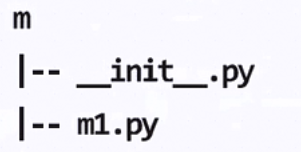
#__init.py文件中 print(__name__) x = 1 #m1.py文件中 print(__name__) y = 5 #test.py文件中 #如何访问到m1.py中的变量m1 #访问到m.m1的变量y的几种实现 #方法1,直接导入m1模块 import m.m1 print(dir())#['__annotations__', ... , 'm'] print(m.m1.y) #方法2,直接导入m.m1的属性y from m.m1 import y print(dir())#['__annotations__', ... , 'y'] print(y) #方法3,from m import * #该方法导入后,无法看到子模块m1,无法访问y #在__init__.py增加__all__ = ['x','m1'],使用__all__提供导出的名称 from m import * print(dir())#['__annotations__' ,... , 'm1', 'x'] print(m1.y) #方法4,不使用__all__ #在__init.py增加from . import m1 from m import * print(dir())#['__annotations__', ... , 'm1', 'x'] print(m1.y)
![]()
#__init.py文件 print(__name__) x = 1 from .m1 import y as _z print(dir())
总结
![]()

![]()

模块变量的修改
#xyz.py文件 print(__name__) X = 10 #test2.py文件 import xyz print(xyz.X) #test.py文件 import xyz print(xyz.X) xyz.X = 50 import test2 #运行test.py文件输出如下: xyz 10 50

模块化高级内容
包管理

主要工具
distutils
![]()
setuptools

![]()
pip

wheel

使用setup.py打包
![]()
https://docs.python.org/3.5/distutils/setupscript.html


from distutils.core import setup #导入setup函数并传参 setup( name = 'm', description = 'Python test m', author = 'chengyu', author_email = '867920363@qq.com', packages = ['m'] # packages = ['m','m.m1','m.m2','m.m2.m21'] ) #name 名字 #version 版本 #packages=[] 打包列表 #packages=['m'] 指定m,就会把m所有的非目录子模块打包 #['m','m.m1.m2.m3'] 逐级建立目录,但是只把m的所有非目录子模块打包,把m.m1.m2.m3打包 #description 描述信息 #author 作者 #author_email 作者邮件 #url 包的主页,可以不写

build命令,编译

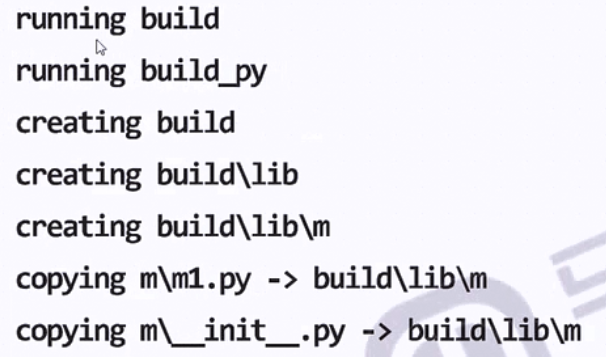

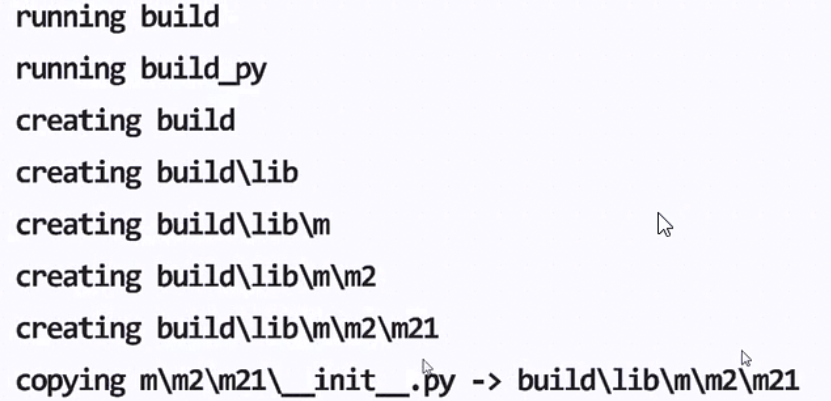

![]()
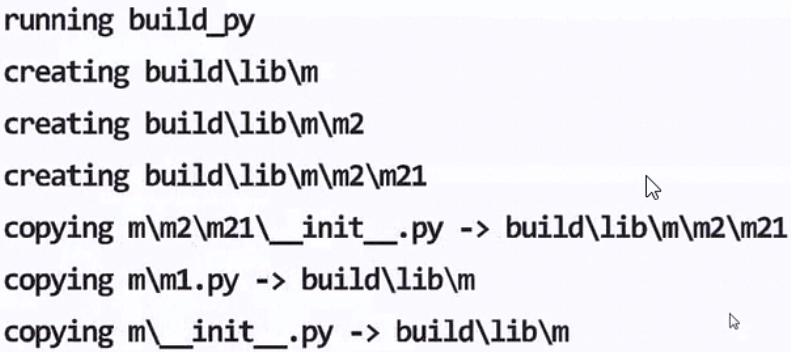
![]()
install命令,安装

install会安装到site-packages路径下。
sdist命令,分发



插件化开发
动态导入
![]()
1.内建函数__import__()

#主程序模块test.py文件 if __name__ == '__main__': mod = __import__('test2') cls = getattr(mod,'A') cls().showme() #test2.py文件 class A: def showme(self): print('I am A')
importlib.import_module()

#test2.py文件 class A: def showme(self): print('I am A') #主程序模块test.py import importlib def plugin_load(plugin_name:str,seq=":"): m,_,c = plugin_name.partition(seq) mod = importlib.import_module(m) cls = getattr(mod,c) return cls() if __name__ == '__main__': #装载插件 a = plugin_load('test2:A') a.showme()
![]()
插件化编程技术
依赖的技术

加载的时机
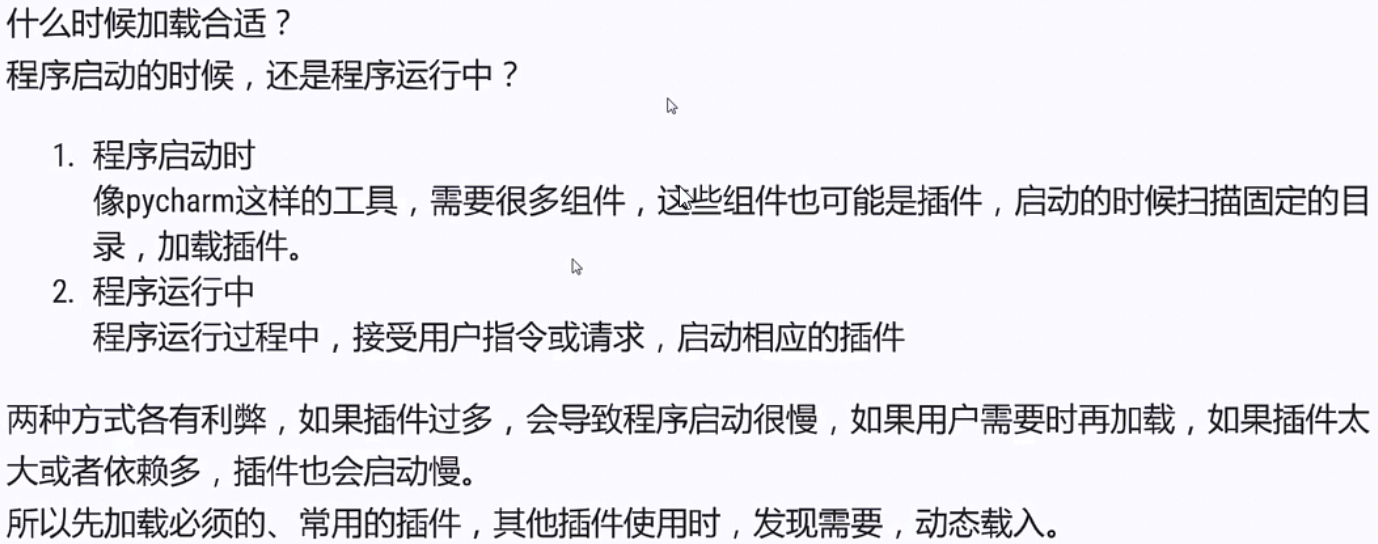
应用

一、__slots__
问题的引出

class A: X = 1 def __init__(self): self.y = 5 self.z = 6 def show(self): print(self.X,self.y,self.z) a = A() print(A.__dict__) print(a.__dict__)

class A: X = 1 # __slots__ = ('y','z')#元组 # __slots__ = ['y','z']#可以 # __slots__ = 'y','z'#可以 __slots__ = 'y'#可以 def __init__(self): self.y = 5 # self.z = 6 def show(self): # print(self.X,self.y,self.z) print(self.X,self.y) a = A() print(A.__dict__) # print(a.__dict__) print(a.__slots__)

继承
class A: X = 1 __slots__ = ('y','z')#元组 def __init__(self): self.y = 5 def show(self): print(self.X,self.y) a = A() a.show() print(A.__dict__) print(a.__slots__) class B(A): pass print('B',B().__dict__)#B {}
![]()
应用场景
![]()
二、未实现和未实现的异常
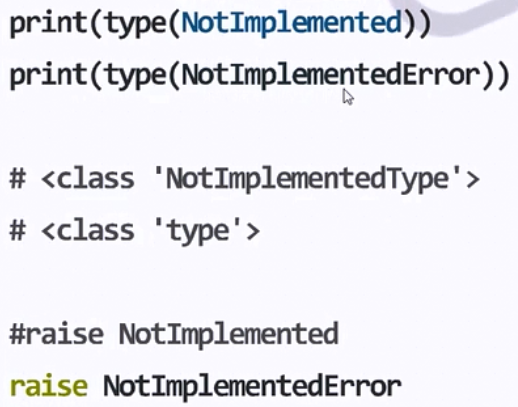

三、运算符重载中的反向方法
![]()
class A: def __init__(self,x): self.x = x def __add__(self, other): print(self,'add') return self.x + other.x def __iadd__(self, other): print(self,'iadd') return A(self.x + other.x) def __radd__(self, other): print(self,'radd') return self.x + other.x a = A(4) b = A(5) print(a,b) print(a+b) print(b+a) b+=a a+=b #运行结果: <__main__.A object at 0x0000000002965080> <__main__.A object at 0x00000000029650B8> <__main__.A object at 0x0000000002965080> add 9 <__main__.A object at 0x00000000029650B8> add 9 <__main__.A object at 0x00000000029650B8> iadd <__main__.A object at 0x0000000002965080> iadd
![]()

class A: def __init__(self,x): self.x = x def __add__(self, other): print(self,'add') return self.x + other.x def __iadd__(self, other): print(self,'iadd') return A(self.x + other.x) def __radd__(self, other): print(self,'radd') return self.x + other.x a = A(4) a+1 #运行结果: <__main__.A object at 0x00000000029356D8> add Traceback (most recent call last): File "F:/code_python_urllib_demo/Python全栈开发--异常及模块/test.py", line 18, in <module> a+1 File "F:/code_python_urllib_demo/Python全栈开发--异常及模块/test.py", line 7, in __add__ return self.x + other.x AttributeError: 'int' object has no attribute 'x'
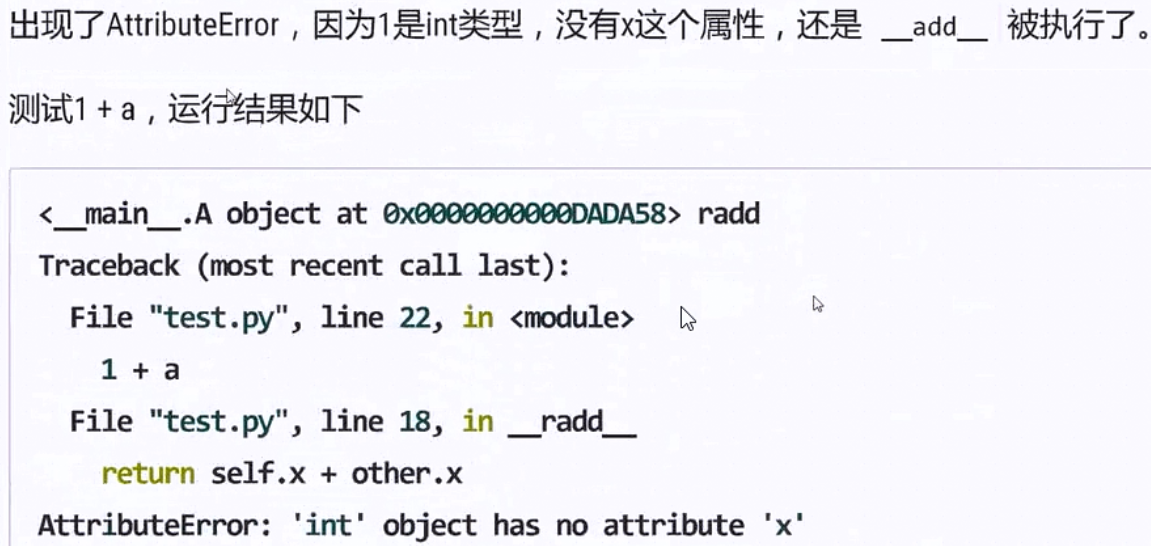

class A: def __init__(self,x): self.x = x def __add__(self, other): print(self,'add') return self.x + other.x def __iadd__(self, other): print(self,'iadd') return A(self.x + other.x) def __radd__(self, other): print(self,'radd') return self.x + other.x class B: def __init__(self,x): self.x = x a = A(4) b = B(10) print(a+b) print(b+a) #运行结果 <__main__.A object at 0x00000000029A5080> add 14 <__main__.A object at 0x00000000029A5080> radd 14

![]()
class A: def __init__(self,x): self.x = x def __add__(self, other): print(self,'add') try: return self.x + other.x except AttributeError: try: x = int(other) except: x = 0 return self.x + x def __iadd__(self, other): print(self,'iadd') return A(self.x + other.x) def __radd__(self, other): print(self,'radd') return self + other class B: def __init__(self,x): self.x = x a = A(4) b = B(10) print(a+b) print(b+a) print(a+2) print(2+a) print(a+'abc') print('abc'+a) #运行结果: <__main__.A object at 0x0000000002965048> add 14 <__main__.A object at 0x0000000002965048> radd <__main__.A object at 0x0000000002965048> add 14 <__main__.A object at 0x0000000002965048> add 6 <__main__.A object at 0x0000000002965048> radd <__main__.A object at 0x0000000002965048> add 6 <__main__.A object at 0x0000000002965048> add 4 <__main__.A object at 0x0000000002965048> radd <__main__.A object at 0x0000000002965048> add 4

做一枚奔跑的老少年!



